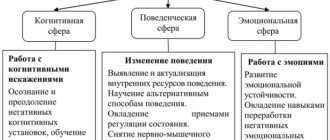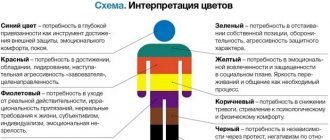If you manage yourself, you manage your life! This is an immutable truth, which is relevant in our time as never before, because the modern world is not only a world of high speeds and a huge number of things to do and worries, but also a world of stress and emotional instability, in which even the calmest person can easily get out of myself.
And today we will talk about mental self-regulation, thanks to which a person can learn to control himself, his manifestations and mental states. If this topic seems interesting to you, we advise you to pay attention to our course “Mental Self-Regulation”.
Direct and indirect methods
Direct methods
Direct methods of influencing the psyche include music. Yes, its effectiveness was experimentally proven back in the 19th century by V. M. Bekhterev, although intuitively music has been used for treatment purposes since ancient times.
The second method is libropsychotherapy, or treatment with special literature. Books draw a person into a fictional world, make them experience the emotions of the characters and distract them from their own experiences.
Indirect methods
- Work and sports are the most effective indirect methods. They provide relaxation, charge with positivity and distract from worries.
- Imagotherapy, or role-playing games, is a method of correcting a condition through personal changes. In the process, new character traits are formed, the personality structure and the experience of problems change.
- Suggestion and self-hypnosis. The spoken words are not criticized, but are accepted by default and become a person’s internal attitude, which corrects his activity.
As you may have noticed, these methods do not necessarily relate to self-regulation, but there are methods exclusively for independent use that develop the ability to self-government. For example, autogenic training. You will also learn about this from the article, but a little later.
Human feelings and emotions
A person’s internal experiences are divided into affects, emotional moods, and feelings. What is their difference?
Affects are short-term outbursts of emotions (anger, fear, despair). Such processes have a strong impact on the functioning of internal organs, especially the cardiovascular system. Affects manifest themselves in a specific situation and last only a short period of time.
Affects can leave deep marks on the mind, so people are advised to change their environment to improve their condition. A person can rarely influence the cause of the feeling of affect; it is an involuntary reaction of the nervous system.
Emotional moods are a state of lower intensity than affects, but longer lasting. They are associated with the highest human needs. These states can relate to both the present and the future, and can influence actions that have not yet been committed.
Feelings are distinguished by the stability of processes, they allow you to make your attitude towards life constant, and they include the most important regulatory function. It is interesting that feelings can come into conflict with affects, but they usually win. True love is stronger than temporary resentment. So the mother, even scolding the child, continues to love him.
True and lasting feelings fill life with meaning and help in achieving high goals and peaks in life.
It is known that a large number of negative emotions causes a state of stress, which is harmful on a physical and mental level. Conditions of constant conflicts and a series of stresses are considered dangerous; they lead to neuroses, sleep disorders, psychoses, and depressive states. This is why emotional self-regulation is important; strong emotions harm a person.
At the physical level, stress leads to stomach diseases, ulcers, hormonal imbalances, asthma attacks, arrhythmias, increased injuries, and the development of harmful addictions. In addition, the emotional state of parents affects the health of future generations.
Tension and stress are caused by the following factors:
- Acceleration of the pace of life;
- Information overload;
- Urbanization;
- Inactivity.
Technological progress has positive and negative sides. Advances in technology make life easier, but they also cause harm to health, for example, an excessive passion for computers leads to a lack of outdoor games, which previously had a lot of emphasis. Now they are trying to restore a healthy lifestyle; there is a fashion for gyms and healthy eating. However, it is worth remembering that simple food and simple movement are useful - running, physical labor.
Of course, a state of stress can also be the cause of personal troubles or be caused by professional stress and worries. Representatives of the following professions are most susceptible to stress loads: miners, police officers, journalists, builders, doctors (especially dentists), actors, politicians, drivers, school teachers. The work of employees of libraries and museums is considered the most relaxed.
The main danger of stress is that in this state, free radicals are formed in cells, which can even lead to the growth of cancer or the proliferation of bacteria and viruses, and the body weakens. Smoking also stimulates the growth of radicals, so it is not an effective way to combat stress.
It is important to find your own ways of emotional self-regulation and interruption of emotional stress. They can be simple: communication with a child, a cat, a walk, contemplation of nature, the main thing is to switch gears. Let's move on to consider psychological techniques.
Psychotechnicians for behavior correction tasks
Decreased arousal
Effectively use:
- distraction and switching of attention;
- goal setting (consider different options);
- physical relaxation;
- psychomuscular and autogenic training;
- breathing exercises for relaxation.
Resource Activation
Effectively use:
- autogenic training for mobilization;
- increased motivation;
- breathing exercises for activity;
- plot performances;
- memories of active emotional states and the situations that caused them;
- mental and sensory stimulation;
- heterosuggestion.
Mental desensitization
Effective:
- presentation of successful behavior;
- self-hypnosis of confidence and neutral attitude towards harmful factors;
- deliberate passive attitude.
Relieving Emotional Stress
Effective:
- listening to music;
- relaxation;
- substitution;
- rationalization;
- fantasy.
Recuperation
Effective:
- meditation;
- suggested dream;
- self-hypnosis for quick recovery.
Regulation of the autonomic system
Effective:
- auto-training;
- heteroregulation;
- breathing exercises.
What is mental self-regulation?
Mental self-regulation is a person’s control of his psycho-emotional state, which is achieved through a person’s influence on himself through the power of words (affirmations), mental images (visualization) and control of breathing and muscle tone (relaxation). Self-regulation methods are used in absolutely any situation, and they always produce the desired effect.
Thus, among the effects of mental self-regulation, three main ones can be distinguished:
- Activation associated with increased psychophysiological activity
- Recovery associated with reduced symptoms of fatigue
- Calmness associated with the elimination of emotional tension
In general, there are, of course, natural methods of mental self-regulation, including:
- Music
- Dancing
- Movement
- Massage
- Interaction with nature and animals
- Food
- Dream
However, these funds cannot be used in many situations, for example, during work, when a person feels tired and observes tension in his mental state.
But it is precisely timely mental self-regulation that can be perceived as a psychohygienic means that can prevent the accumulation of overstrain, restore strength, normalize the psycho-emotional state and mobilize the body's resources.
For this reason, the most accessible methods of natural self-regulation are also:
- Expressing compliments, praise, etc.
- Breathing fresh air
- Real or imagined bathing in the sun
- Concentrating on pleasant things, photographs and flowers
- Contemplation of landscapes and panoramas
- Muscle relaxation, stretching and other similar movements
- Reflections on the pleasant and good
- Humor, smile, laughter, etc.
But, in addition to natural ones, there are special methods of self-regulation, which in some cases are also called self-influence. It is about them that will be discussed further.
Autogenic training
The method was developed in 1930 by the German psychotherapist I. G. Schultz. In Russia, the method has been used and studied since 1950.
At first, auto-training was used only for the treatment of nervous disorders, but gradually began to be used for preventive purposes. Today this is a popular method of unloading the emotional and mental state in all areas and activities: study, work, relationships, and so on.
Auto-training in the modern sense even has its own subtypes:
- psychomuscular training (PMT);
- psychotonic training (PTT);
- psychoregulatory training (PRT).
But the basis of any auto-training is a relaxation mechanism, that is:
- mastering muscle relaxation techniques;
- development of skills for sensing heat and cold in the body;
- increasing concentration and volitional attitude towards the general condition of the body.
The purpose of auto-training is to relieve muscle and emotional tension, to instill in a relaxed state the development of volition.
I suggest you get acquainted with morning auto-training, which will charge you with energy and positivity for the whole day. You can perform it at any time, even immediately after waking up, while lying in bed. You just need to say the following words (installations). It is very important to speak on your own behalf in the present tense.
The text can be saved and printed as a reminder
Literature
- Alekseev A.V. On the adequacy of self-hypnosis formulas // Theoretical and applied studies of mental self-regulation / Ed. N. M. Peysakhova. Kazan: KSU Publishing House, 1976.
- Grimak L.P., Zvonikov V.M., Skrypnikov A.I. Mental self-regulation in the activities of a human operator // Questions of cybernetics. Mental states and performance effectiveness / Ed. Yu. M. Zabrodina. M.: Publishing House of the USSR Academy of Sciences, Scientific Council on the complex problem “Cybernetics”, 1983.
- Dikaya L.G., Semikin V.V. The regulatory role of the image of the functional state in extreme conditions of activity // Psychological Journal. 1991. T. 12. No. 1. P. 55-65.
- Konopkin O. A. Psychological mechanisms of activity regulation. M.: Nauka, 1980.
- Leonova A. B., Kuznetsova A. S. Psychological technologies for managing the human condition. - M: Smysl, 2009. - 311 p. — ISBN 978-5-89357-241-4
- Morosanova V.I. Individual style of self-regulation. M.: Nauka, 2001.
- Morosanova V.I. Self-regulation and human individuality / Institute of Psychology RAS; Psychological Institute RAO. - M.: Nauka, 2010. - 519 p. — ISBN 978-5-02-037102-6
- Oboznov A. A. Mental regulation of operator activity (in special conditions of the working environment). M.: Publishing House IP RAS, 2003
Self-hypnosis
In fact, the technique described above is self-suggestion. With the help of these words, your faith in your own strength and the implementation of your plans increases. You get set up for success and understand that everything depends only on you.
Self-hypnosis is always positive statements in the first person, spoken in the present tense. You can come up with your own up-to-date and customized settings. Self-hypnosis directly affects the psychophysiology of the brain, forces it to concentrate on the goal.
There are several principles for constructing phrases. You are addressing the subconscious, so it is imperative to follow them.
- Use positive and affirmative phrases and avoid “not” and “never”. For example, instead of “my head doesn’t hurt,” say “the pain has left my head.”
- Maximum specificity. Don't skimp on your words and sentences. Break a big goal into small ones. For example, “I am successful” is a common phrase. Decipher what this means in your mind.
- Try to replace abstractions. For example, not “the head has passed,” but “the forehead has cooled.”
- Do not complicate the wording, use simple words, most importantly, understandable to you.
- One phrase – maximum 4 words.
- Always only the present tense. The subconscious perceives this as already accomplished, and what is said actually happens.
Functions and mechanisms
There are different self-defense mechanisms with a similar principle of operation. They act at the levels of organs and cells.
The main function of the method is to change mental activity, allowing the subject to achieve a state of balance and harmony. Thanks to this, a person can perform several actions:
- cope with any adversity that arises throughout life;
- control your condition in various conflict situations;
- restore your own strength;
- think rationally under stress.
Meditation
Meditation involves working with attention: relaxing it or, conversely, increasing concentration. The purpose of meditation is to relieve emotional stress and develop the ability to stop the flow of thoughts.
Focus on the score
Count slowly from 1 to 10, concentrating on each number. You shouldn't think about anything else. If you realize that your thoughts have again “fled away” into your problems, then start counting from the beginning. Count like this for a few minutes (without losing your way).
Focusing on emotions and mood
- Record your inner thoughts, inner speech.
- Stop her.
- Catch your mood and focus on it.
- Rate it: good, bad, sad, happy, average, upbeat.
- Now focus on your emotions. Imagine yourself in an elevated, joyful state. To do this, remember a joyful event in life, a pleasant image.
- Get out of the state of relaxation.
- Go through reflection, that is, evaluate your state and thoughts now and during the exercise.
Classification and distinctive features
Self-regulation in psychology is a rather broad phenomenon in its understanding, used for various purposes. The most important prerequisites that help to develop one or another form of self-regulation boil down to the fact that with the help of conscious attention to one’s own psychological and mental processes, one can learn to manage emotions and thoughts.
Self-regulation is largely influenced by external circumstances, but you can learn to control your own reactions, experiences and sensations caused by situations. To better understand how self-regulation works, it is necessary to separate its psychological, emotional and reflexive components.
Mental self-regulation
The tasks of mental self-regulation are aimed at developing stress resistance and rapid restoration of strength. The ability to maintain high motivation and critically perceive any comments is the basis for healthy personality development. Psychological self-regulation helps to manage one’s own condition depending on the needs and norms of society.
As a result of well-developed psychological regulation, a person develops a strong immunity to unfounded criticism and an adequate assessment of his own achievements and capabilities, which is a sign of a self-sufficient personality. Thus, psychological self-regulation is the basis for the successful socialization of an individual.
Emotional self-regulation
Emotional self-regulation is the ability to quickly recognize and regulate the manifestation of one’s own emotions caused by external circumstances. This emotion control skill is based on the ability to correct strong emotional states, both negative (in the case of devastating criticism) and positive (excessive fun).
Emotional self-regulation is the conscious experience of emotions at the right pace, as well as the ability to respond flexibly and spontaneously to any circumstances. As a result, controlling your own feelings not only gives you confidence in your own abilities, but also gives you a clear understanding of how to achieve your plans.
Reflective self-regulation
The most important aspect of self-regulation is the ability to reflect and analyze one’s own feelings and how they change depending on the situation. This is a conscious approach that helps you understand your own strengths, capabilities and priorities.
Reflexive self-regulation contributes to a clearer representation of personal needs, modeling of problems and their solutions, helps to control the process of their implementation and, if necessary, adjust one’s own actions.
Trainings
Perhaps the most popular psychological technique today. There are many trainers and people willing to undergo training. Trainings are divided into separate profiles covering narrow topics. For example, training to improve stress resistance is popular. Most often they are directed:
- to increase self-esteem (or decrease to the correct level if necessary), emotional stability, self-confidence;
- formation of motivation to achieve success and behavior strategies under stress.
Food for thought: “Aggression”
Aggression (from the Latin aggressio - attack) is the destructive actions, behavior, emotions and feelings of a person, causing him and (or) others psychological discomfort, and in some cases, physical harm.
According to the place of manifestation (in the external behavior of a person or in the inner world of a person), aggression is divided into two types:
• external – words, actions, human behavior; • internal - negative emotions, feelings and thoughts that are either not reflected in behavior or are manifested indirectly (for example, in facial expressions, gestures).
By direction, aggression is also divided into two types:
• aggression directed against others; • aggression directed at oneself (auto-aggression).
The combination of two criteria allows us to distinguish four types of aggression (see figure).
Breathing exercises
There are many options for breathing techniques, but it is a mistake to believe that they are all aimed at slowing down mental reactions. On the contrary, there are exercises that activate the brain.
Relaxation exercises
The goal is to master conscious natural breathing, relieve muscle tension and tension, and calm emotions. I want to introduce you to some exercises.
"Rest"
Place your feet shoulder-width apart, straighten up, and inhale. As you exhale, bend down, relax your neck and shoulders (as if they were hanging calmly on their own). Stay in this position for 1-2 minutes. Breathe deeply, watch your breathing. Slowly straighten up.
"Conscious Breathing"
Sit comfortably and relax, but keep your back straight. Take your first shallow breath in and out. Then inhale and exhale a second time, but deeper. And for the third time, inhale with your whole chest, but exhale very slowly (one in three).
"Breathing under stress"
Breathing is rhythmic and combined with walking. The scheme is as follows: two steps - inhale, two steps - exhale. Gradually increase the duration of exhalation, that is, then it will be: two steps - inhale, three steps - exhale, and so on.
Arousal exercises
The purpose of the following exercises is to increase neuropsychic activity and activate resources.
"Lock"
Sit up straight, place your hands on your knees and clasp them together. Inhale and at the same time raise your arms up (palms facing up). Hold your breath for a couple of seconds, exhale sharply through your mouth and “drop” your hands on your knees.
"Getting ready for work"
You need to breathe according to a certain pattern described below. The first number is inhalation, the second (in brackets) is retention, the third is exhalation.
2(2)+2; 4(2)+4; 4(2)+5; 4(2)+6; 4(2)+7; 4(2)+8; 8(2)+5; 9(4)+5; 10(5)+5.
Techniques and exercises for self-regulation
Essentially, self-regulation exercises are actions to manage emotions. Their main quality is that they have a complex effect on the active points of the body. This produces hormones that increase the body’s resistance. Exercises to relieve tension:
- “Thoughts on paper” is useful before bed to transfer internal tension to the outside world. All thoughts are written down on a piece of paper until “your head becomes clear.”
- “Thinking stretches” are effective for moving away from negativity. If you notice anxiety in yourself, you can play the mental game “bad, but also good, because” to increase your flexibility of thinking.
- “Imagination with benefit”, that is, visualization, since due to the images in the mind the body “trusts” them. If you need to become cheerful, you need to imagine yourself like that.
Self-regulation exercises will help you manage your emotions
Methods of psychological self-regulation are useful for stress, loss of strength, emotional burnout and similar situations. Self-impact is a good reason to always be in a cheerful mood.
Relaxation
The goal is to realize, find and relieve muscle tension; learn muscle control.
"Tension-relaxation"
Stand up straight, focus on your right arm and tense it. After a few seconds, release the tension. Do the same with your left hand, then with both at the same time. After - with the right leg, left leg, both legs, lower back, neck.
"Muscle Energy"
- Bend your right index finger as much as possible (without damaging it).
- Feel where the tension goes. The finger itself, the hand, the elbow, the neck?
- Now try to gradually ease the tension: in the neck, shoulder, elbow. But the finger is still bent and tense.
- Release tension from your other fingers. We don't touch the index finger.
- Managed? Release the tension from your index finger.
- Do the same with your left leg (press your heel into the floor, do not overdo it).
- Where does the tension go? Gradually relax, as in the case of a finger.
- After this, tense your back. I will make a reservation that this exercise is not suitable for people with a bad back (hernia, osteochondrosis). If your back is healthy, then bend over and imagine that a box is placed on your back.
- Where does the tension go? Gradually relax your entire body, last but not least your back.
Involuntary visualization
The goal is distraction from stressful situations and obsessive thoughts by means of involuntary attention against the background of relaxation.
- Close your eyes and look as if at the back of your eyelids. In a couple of minutes you will see dots, spots, lines.
- After some time, these spots may begin to form into some images, faces, objects.
- It is important to do this in a state of relaxation, then gradually obsessive thoughts will come out through these barely noticeable images.
- Keep your face and body relaxed. Don’t try to draw something yourself, but just look, as if from the outside, at what appears.
- This exercise requires skill. During the first practices, attention often slips; you need to consciously return it to the points.
- Then open your eyelids and assess your condition.
Theories and levels
There are several current theories of self-regulation, each of which has certain features.
System-activity regulation
Its author is L. G. Dikaya. It is simultaneously considered as a system and an activity. The author identified 4 levels of self-regulation:
- Involuntary - regulations that are based on activity that manifests itself during inhibition and excitement of the psyche. The individual cannot control involuntary reactions, but their duration is short-lived.
- Conscious - due to constant discomfort, a person faces the choice of developing self-regulation or performing some action to get out of the current situation. He sets priorities, changes the value of needs, evaluates motives. At the same time, self-programming, self-persuasion, self-hypnosis, introspection, and self-order begin to work. Personal and cognitive changes occur.
- Conscious regulation. The person feels discomfort and can realize the level of negative state. After realizing the situation, the subject makes a choice between ways to change his own state. This can be a manifestation of willpower, auto-training, psychophysical exercises, self-control.
- Arbitrary level. Self-regulation manifests itself only under severe stress and extreme fatigue. This may include holding your breath, muscle tension, convulsions, speech activity, emotions, gestures that cannot be controlled.
System-functional theory
Its author is A. O. Prokhorov. He viewed the processes of self-regulation as a change in mental states from one to another. Manifests itself in two ways:
- The functional structure of the processes of regulation of mental state develops gradually.
- The subject uses conscious methods of regulation to achieve the required state. To complete the task, the subject goes through several intermediate states.
The success of the technique is influenced by the adequacy of the image that was presented and the degree of awareness of the current state. To describe the current situation, several factors must be taken into account:
- breathing rhythm;
- bodily sensations;
- thoughts, feelings;
- imagination, memories;
- perception of time and space.
After accurately understanding the current situation, you can develop a technique for transitioning from a negative state to a necessary one.
"Anchoring" method
A self-regulation technique associated with conditioned reflexes, that is, the “stimulus-reinforcement” scheme. Surely it has happened to you that a song or smell evoked specific memories and emotions. This is your “anchor”, which can be positive or negative. Someone's voice or gesture can also be an anchor.
Self-regulation in the form of anchoring involves the conscious setting of “anchors” and their reasonable use, that is, the release of the necessary resource in a stressful situation.
- Identify a situation in which you need resources.
- Determine specifically what resource is needed (confidence, courage, determination, etc.).
- Ask yourself: “If I had this resource now, would I really use it?” If the answer is yes, then you made the right choice and you can move on. If you make a mistake, then select a new resource.
- Remember a situation when you had this resource.
- Choose three “anchors”: what you hear, what you feel, what you see.
- Change your position in space, reproduce in your memory the situation when you had the resource, achieve a peak state.
- Exit it and return to your original place.
- Recreate the situation again and attach three “anchors”. Hold them as long as needed.
- Check the success of the operation: “turn on the anchors”. Are you getting into the desired state? If yes, then everything is fine. If not, repeat the previous point.
- Determine the signal that will hint to you in a difficult situation that it is time to “drop anchor.”
- If necessary, immediately create a complex of evoked states, emotions, and feelings.
Methods of self-influence
So, methods of self-influence can be divided into:
- Related to verbal influence
- Movement related
- Breath-related
Let's look at each of them in more detail.
Methods of self-regulation associated with verbal influence
The impact of words is different in that it activates the conscious mechanisms of self-hypnosis. As a result, a direct effect on the psychophysiological functions performed by the body begins. As a rule, verbal self-suggestions are formulated through short and simple statements that do not use the particle “not.”
Verbal influence can be expressed in self-orders, self-programming and self-approval.
Self-orders
Self-orders are short and abrupt orders that a person gives to himself. A person should use self-orders when he is convinced that it is necessary to behave in a specific way, but there are some problems with organizing his behavior in this regard.
You should tell yourself something like: “Speak calmly!”, “Be silent, be silent!” or “This is just a provocation. Stop reacting!” - such self-importances will allow you to restrain your emotions and behave within the framework of decency, ethics and dignity.
You should work with self-orders like this:
- Self-order is formulated
- The self-command is repeated to oneself several times
- Self-order is pronounced out loud (if possible)
Self-programming
In some life situations a person needs to “look back”, i.e. Refresh your memory of past successes in similar situations. This can become an indicator that there are hidden volitional, intellectual, spiritual and even physical reserves in him, as well as indicate opportunities and give self-confidence.
You can set yourself up for success using self-programming. It is done like this:
- The person must remember a situation in which he has already successfully dealt with similar problems
- Then you need to use affirmation. To enhance the effect, you can give it the current tense, for example: “Now I can do this”, “Today I will be as confident as possible”, “Now I will be persistent as never before”, etc.
- After this, you should repeat the received affirmation several times (mentally, in front of a mirror, or simply out loud, if the situation allows)
Self-approval
Quite often, people cannot receive a positive assessment of themselves and their actions from the outside, which is very painful in situations with neuropsychic stress. A lack of positive evaluation can cause irritability, nervousness and even aggressiveness. For this reason, a person must encourage himself.
For self-approval or self-encouragement, you should simply say certain words to yourself, such as: “I’m super!”, “Well done!”, “Handsome!”, “Clever!”, “It worked,” etc.
Afterword
Self-regulation really works. The body and brain are one, as psychosomatics has long shown. Therefore, you should not be skeptical about exercises that seem to have little to do with psychology.
But you need to approach the development of self-regulation carefully and following a number of rules:
- clearly see the goal and stick to it;
- the process of developing a skill must be consistent and purposeful;
- be prepared for high energy costs, especially at the beginning of the journey;
- despite consistency and purposefulness, adhere to diversity in the development of self-regulation methods.
It is impossible to create one set of self-regulation methods for a lifetime, since the very ability to self-government is associated with such changeable elements as needs, personality and character traits, motives, and more. You can read more about the intricacies of developing self-regulation and what it is in the article “Self-regulation - what is it in psychology. Concept, types and functions."
The techniques presented in the article were borrowed from the book by T. G. Volkova “Workshop on the psychology of self-awareness and self-regulation: methodological materials for the course.” You can find this literature and learn more about other techniques and methods of self-regulation.
The concept of self-regulation in psychology
Self-regulation in psychology is a comprehensive approach to developing one’s own reactions, emotions, thoughts and level of motivation. The concept is broad, and depending on the purpose, it can be used to improve psycho-emotional balance, increase the level of attention and stability of behavioral reactions to external situations.
Thus, self-regulation is a process of internal activity of each person, the main goal of which is to learn to manage one’s own state and activity.
The process of mastering a skill begins when any contradictions arise related to a person’s motivation, worldview, or his understanding of the norms of behavior in society. Depending on different socio-psychological situations, self-regulation can perform the tasks of developing personal perception of events, developing volitional efforts and self-control.
The development of self-regulation is an important integral process of becoming a holistic personality, which is able to analyze, evaluate and correct one’s own behavior in the context of the situation that has arisen.









